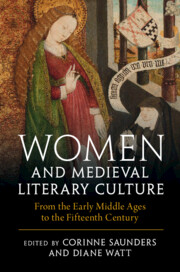Book contents
- Women and Medieval Literary Culture
- Women and Medieval Literary Culture
- Copyright page
- Contents
- Illustrations
- Contributors
- Acknowledgements
- Introduction
- I Patrons, Owners, Writers, and Readers in England and Europe
- II Circles and Communities in England
- Chapter 4 Ancrene Wisse, the Katherine Group, and the Wooing Group as Textual Communities, Medieval and Modern
- Chapter 5 Syon Abbey and the Birgittines
- Chapter 6 What the Paston Women Read
- III Health, Conduct, and Knowledge
- IV Genre and Gender
- V Women as Authors
- General Index
- Index of Manuscripts
- References
Chapter 5 - Syon Abbey and the Birgittines
from II - Circles and Communities in England
Published online by Cambridge University Press: 28 July 2023
- Women and Medieval Literary Culture
- Women and Medieval Literary Culture
- Copyright page
- Contents
- Illustrations
- Contributors
- Acknowledgements
- Introduction
- I Patrons, Owners, Writers, and Readers in England and Europe
- II Circles and Communities in England
- Chapter 4 Ancrene Wisse, the Katherine Group, and the Wooing Group as Textual Communities, Medieval and Modern
- Chapter 5 Syon Abbey and the Birgittines
- Chapter 6 What the Paston Women Read
- III Health, Conduct, and Knowledge
- IV Genre and Gender
- V Women as Authors
- General Index
- Index of Manuscripts
- References
Summary
The rich textual history of Syon Abbey, the only English house of St Birgitta of Swedenߣs Order of St Saviour, is the focus of this essay. Although there is limited evidence of English Bridgettine nuns authoring their own texts, St Birgitta, Syon Abbey, and its community of nuns as well as monks had profound and multiple influences on womenߣs literary culture in fifteenth- and early-sixteenth-century England. While the significance of Syon within the late medieval English cultural landscape cannot be overemphasised, its (textual) community is also representative of the intricacies of womenߣs literary culture. Syon women, including as well as superiors aristocratic lay women with close ties to the abbey, were engaged in the commissioning of texts. The Syon community, led by Abbess Elizabeth Gibbs, was quick to exploit the new technology of printing, and also supported by the patronage of wealthy noble women, such as Lady Margaret Beaufort. However, the textuality of the abbey expanded beyond these powerful women to include the wider community of Syon nuns, and beyond England into continental Europe.
- Type
- Chapter
- Information
- Women and Medieval Literary CultureFrom the Early Middle Ages to the Fifteenth Century, pp. 104 - 123Publisher: Cambridge University PressPrint publication year: 2023

